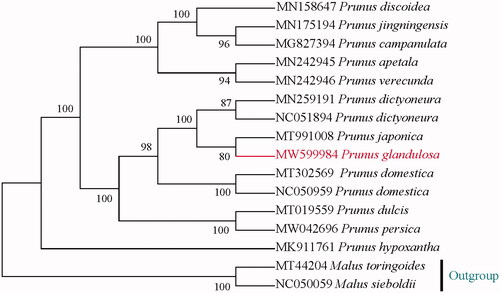Abstract
Prunus glandulosa Thunb. is an ornamental species in the genus Prunus (Rosaceae) mainly distributed in eastern China. It is often cultivated in gardens, roadsides, or shrub clusters. It looks like a cherry but resembles to prunes as well. We obtained the complete chloroplast genome of P. glandulosa using next-generation sequencing technology. The chloroplast genome is 158.078 bp in length with typical tetrad structure. It includes two copies of inverted repeats (IRs, 26.385 bp), a large single copy (LSC, 86.269 bp) and a small single copy (SSC, 19.039 bp). The total GC content is 36.7%, including 85 protein-coding genes (PCGs), 36 transfer RNA genes (tRNA), and eight ribosomal RNA genes (rRNA). The maximum-likelihood phylogeny using the full length of chloroplast genomes indicates that P. glandulosa is closer to prunes than to cherries.
Prunus glandulosa Thunb. is an ornamental species in the genus Prunus (Rosaceae) mainly distributed in eastern China. It is extensively cultivated worldwide for its beauty of abundant flowers. Prunus glandulosa (Citation1929) is usually a small dwarf very similar to P. japonica and this group of species was classified into dwarf cherries (Cerasus subg. Microcerasus). However, the morphology of dwarf cherries is also very similar to prunes (Prunus s. s.). The phylogeny based on chloroplast genome has not been reported. Therefore, markers showed that the dwarf cherries do not have a close relationship to true cherries, instead, it is independent to either cherries or prunes. To test the taxonomic statuses of dwarf cherries and pinpoint their systematic position in Prunus, we determined the complete chloroplast genome of P. glandulosa and constructed the phylogeny of the dwarf cherries and other major lineages in Prunus subg. Prunus using the complete chloroplast genome sequences.
Total genomic DNA was extracted from the silica gel dried and clean leaves of P. glandulosa sampled from Wuhan Botanical Garden (China; N30°31′21.62″, E114°25′34.99″). Meanwhile, a sample (BOP002698) was corrected from the specimen housed in the herbarium of Institute of Botany, Chinese Academy of Sciences (PE). Total genomic DNA was extracted using modified cetyltrimethy lammonium bromide (mCTAB) method (Li et al. Citation2013). An Illumina DNA library was constructed using the total DNA and the DNA library was sequenced on Illumina HiSeq2500 platform for paired-end 150 bp reads (PE150). The genome is assembled using novoplasty (Dierckxsens et al. Citation2017, Citation2020) and annotated using PGA (Qu et al. Citation2019).
The newly assembled chloroplast genome (MW599984) of P. glandulosa is 158.078 bp in length with typical tetrad structure. It includes two copies of inverted repeats (IRs, 26.385 bp), a large single copy (LSC, 86.269 bp) and a small single copy (SSC, 19.039 bp). The GC contents of LSC, SSC, and IR regions are 34.5%, 30.4%, and 42.5%, respectively, and the whole genome is 36.7%. A total of 129 genes were annotated, including 85 protein-coding genes (PCGs), 36 transfer RNA genes (tRNA), and eight ribosomal RNA genes (rRNA).
To determine the taxonomic statuses of dwarf cherries and their systematic position in Prunus, we downloaded all chloroplast genomes of species in Prunus subg. Prunus and of Prunus hypoxantha (Prunus subg. Padus) as an outgroups in GenBank, aligned them with MAFFT (Katoh and Standley Citation2013), and constructed a maximum likelihood (ML) phylogeny () using IQ-TREE (Nguyen et al. Citation2015) using the best-fitting model K3Pu + F + I determined by ModelFinder (Kalyaanamoorthy et al. Citation2017). The phylogeny shows that the dwarf cherries are more similar to prunes than to true cherries and the dwarf cherries are actually dwarf prunes.
Disclosure statement
The authors declare no conflicts of interest and are responsible for the content in the manuscript.
Data availability statement
The genome sequence data that support the findings of this study are openly available in GenBank of NCBI at (https://www.ncbi.nlm.nih.gov/) with the accession number is MW599984. The associated BioProject, SRA, and Bio-Sample numbers are PRJNA742221, SRR14982105, and SAMN19945336, respectively
Additional information
Funding
References
- Dierckxsens N, Mardulyn P, Smits G. 2017. NOVOPlasty: de novo assembly of organelle genomes from whole genome data. Nucleic Acids Res. 45(4):e18.
- Dierckxsens N, Mardulyn P, Smits G. 2020. Unraveling heteroplasmy patterns with NOVOPlasty. NAR Genom Bioinform. 2(1):lqz011.
- Katoh K, Standley D. 2013. MAFFT multiple sequence alignment software version 7: improvements in performance and usability. Mol Biol Evol. 30(4):772–780.
- Kalyaanamoorthy S, Minh BQ, Wong TKF, von Haeseler A, Jermiin LS. 2017. ModelFinder: fast model selection for accurate phylogenetic estimates. Nat Methods. 14(6):587–589.
- Nguyen LT, Schmidt HA, von Haeseler A, Minh BQ. 2015. IQ-TREE: a fast and effective stochastic algorithm for estimating maximum-likelihood phylogenies. Mol Biol Evol. 32(1):268–274.
- Li J, Wang S, Yu J, Wang L, Zhou SL. 2013. A modified CTAB protocol for plant DNA extraction. Chin Bull Botany. 48:72–78.
- Prunus glandulosa. 1929. Bulletin of popular information. Vol. 3(5), Boston (MA): Arnold Arboretum, Harvard University; p: 20.
- Qu X-J, Moore MJ, Li D-Z, Yi T-S. 2019. PGA: a software package for rapid, accurate, and flexible batch annotation of plastomes. Plant Methods. 15:50–12.

